Question
Which of the following regions of the globe exhibits highest species diversity? [NEET (Sep.) 2020]
(a) Madagascar
(b) Himalayas
(c) Amazon forests
(d) Western Ghats of India
Answer/Explanation
Ans. (c)
The Amazonian rain forest in South America has the greatest biodiversity on earth. Rainforests have high biodiversity because they are abundant in nutrients, energy and have a favorable climate for the biodiversity to prosper.
Question
Decline in the population of Indian native fishes due to introduction of Clarias gariepinus in river Yamuna can be categoriesd as [NEET (Odisha) 2019]
(a) co-extinction
(b) habitat fragmentation
(c) overexploitation
(d) allien species invasion
Answer/Explanation
Ans. (d)
Decline in the population of Indian native fishes due to introduction of Clarias gariepinus in river Yamuna can be categorised as alien species invasions. It is posing a threat to the indigenous catfishes in our rivers and causing a loss of biodiversity.
Question
Which of the following is the most. important cause for animals and plants being driven to extinction? [NEET (National) 2019]
(a) Drought and floods
(b) Economic exploitation
(c) Alien species invasion
(d) Habitat loss and fragmentation
Answer/Explanation
Ans. (d)
Habitat loss and fragmentation is the most important cause for animals and plants being driven to extinction. Due to habitat fragmentation and loss, a $14 \%$ of the earth’ land surface, rainforest has shrunk to only $6 \%$ in last few years.
Fragmentation and loss of large
habitats due to various human activities
badly affects mammals and birds
requiring large territories. Certain
animals with migratory habits are also affected by habitat loss and
fragmentation. Thus, their populations are driven towards decline and extinction.
On the other hand, droughts and floods: economic exploitation and alien species invasion affect only a small part of population at a time.
Question
Which is the National Aquatic Animal of India? [NEET 2016, Phase I]
(a) River dolphin
(b) Blue whale
(c) Seahorse
(d) Gangetic shark
Answer/Explanation
Ans. (a)
River dolphin is the National Aquatic Animal of India. This mammal exclusively reside in freshwater or brackish water.
Question
Plants such as Prosopis, Acacia and Capparis represent examples of tropical [CBSE AIPMT 1998]
(a) grasslands
(b) thorn forests
(c) deciduous forests
(d) evergreen forests
Answer/Explanation
Ans. (b)
Flora of thorn forests include Prosopis cineraria, Acacia senagal, Capparis decidua, Salvadora oleoides, Asparagus ras and Ephedra foliata.
cemosuQuestion
Alexander von Humbolt described for the first time [NEET 2017]
(a) ecological biodiversity
(b) law of limiting factor
(c) species area relationships
(d) population growth equation
Answer/Explanation
Ans. (c)
Alexander von Humbolt was a great German naturalist and geographer. He did extensive explorations in the wilderness of South American forests. He established species area relationship.
He observed that with in a region, species richness increase with increasing explored area, but upto a certain limit. Infact, the relationship between species richness and area for a variety of taxa turns out to be a rectangular hyperbola as shown in figure below
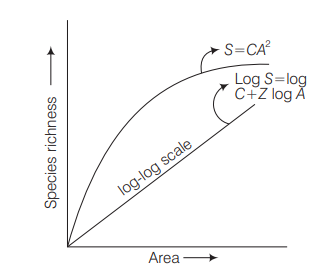
Showing species area relationship
Note that on log scale the relationship becames linear.
On a logarithmic scale, the relationship is a straight line described by the equation.
$\log S=\log C+Z \log A$
where,
$S=$ Species richness
$\mathrm{A}=$ Area
$Z=$ Slope of the line (regression coefficient]
$C=Y$-intercept
Question
Which of the following is the most important cause of animals and plants being driven to extinction? [NEET 2016, Phase I]
(a) Alien species invasion
(b) Habitat loss and fragmentation
(c) Co-extinctions
(d) Over-exploitation
Answer/Explanation
Ans. (b)
There are four major causes of biodiversity loss in which most important cause driving animals and plants to extinction is habitat loss and fragmentation.
Question
Red List contains data or information on [NEET 2016, Phase II]
(a) all economically important plants
(b) plants whose products are in international trade
(c) threatened species
(d) marine vertebrates only
Answer/Explanation
Ans. (c)
IUCN maintains a Red Data Book which is a catalogue of the taxa facing the risk of extinction. The threatened species are the one which are at more risk of become extinct. The list of these species is called Red List.
Question
Which of the following is correctly matched? [NEET 2016, Phase II]
(a) Aerenchyma – Opuntia
(b) Age pyramid – Biome
(c) Parthenium hysterophorus – Threat tobiodiversity
(d) Stratification – Population
Answer/Explanation
Ans. (c)
Parthenium hysterophorus (carrot grass) is an alien species introduced inadvertantly for some economic use, turned invasive causing decline or extinction of the indigenous species.
The ather options are wrong because
(a) Aerenchyma is found in aquatic plants (Vailisneria, Hydrilla), but Opuntia is a xerophytic plant.
(b) Biome is total sum of all ecosystem present in the planet earth whereas age pyramid is the graphical representation of age of organisms of one population at a specific time.
(d) Stratification is related with different layers of vegetation in an ecosystem (like forest/grass land) and population is a term referred to a group of same kind of organisms which can freely interbreed.
Question
Given below is the representation of the extent of global diversity of invertebrates. What groups the four portions $(A-D)$ represent respectively? [CBSE AIPMT 2014]
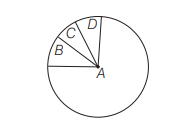
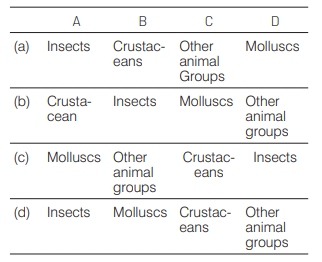
Answer/Explanation
Ans. (c)
Phylum-Arthropoda is the largest phylum of the animal kingdom with its largest group, i.e. insecta(A). The second largest population is of phylum-Mollusca (B). The third one is occupied by crustaceans (C). All other animals combinally indicate the (D) portion of pie chart.
Question
A species facing extremely high risk of extinction in the immediate future is called [CBSE AIPMT 2014]
(a) vulnerable
(b) endemic
(c) critically endangered
(d) extinct
Answer/Explanation
Ans. (c)
The extremely highest risk category assigned by the IUCN Red List for wild species is critically endangered species. These are those species that are facing a very high risk of extinction in near future. There are currently 2129 animals and 1821 plants which have been recorded in this category.
Question
The organisation which publishes the Red List of species is [CBSE AIPMT 2014]
(a) ICFRE
(b) IUCN
(c) UNED
(d) WWF
Answer/Explanation
Ans. (b)
IUCN is International Union for Conservation of Nature which publishes the Red List of threatened species or Red Data List which assesses the conservation status of species. It is an international organisation founded in October, 1948. Its head quarter is in Gland, Switzerland.
Question
Which of the following represent maximum number of species among global biodiversity? [NEET 2013]
(a) Algae
(b) Lichens
(c) Fungi
(d) Mosses and ferns
Answer/Explanation
Ans. (c)
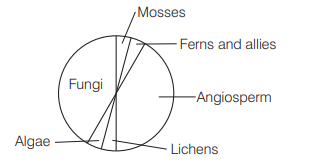
The following figure shows global biodiversity of fungi, mosses, ferns, algae, lichens and angiosperms. Therefore, from the above figure it is clear that fungi has maximum number of species among the global biodiversity.
Question
Which one of the following expanded forms of the following acronyms is correct? [CBSE AIPMT 2011]
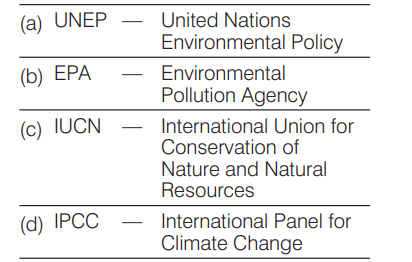
Answer/Explanation
Ans. (c)
IUCN or IUCNNR (International Union for Conservation of Nature and Natural Resources) is now known as WCU (World Conservation Union). Its headquarter is at Gland. Switzerland. It studies the threat to biodiversity in all parts of the world by gathering information about the geographical distribution, population size and population changes of various taxa. It prepares a Red List or Red Data Book categorising different organisms belonging to different categories.
Question
ICBN stands for [CBSE AIPMT 2007]
(a) Indian Congress of Biological Names
(b) International Code of Botanical Nomenclature
(c) International Congress of Biological Names
(d) Indian Code of Botanical Nomenaclature
Answer/Explanation
Ans. (b)
ICBN stands for International Code of Botanical Nomenclature. A body of rules and recommendations governing botanical names.
Question
Which one the following pairs of organisms are exotic species introduced in India? [CBSE AIPMT 2007]
(a) Ficus religiosa, Lantana camara
(b) Lantana camara, water hyacinth
(c) Water hyacinth, Prosopis cineraria
(d) Nile perch, Ficus religiosa
Answer/Explanation
Ans. (c)
A species of organism that is not native to a locality where it is flourishing and have been moved there from its natural range by humans or other agents is called exotic species, e.g. water hyacinth, Prosopis cineraria, etc.
Question
Which of the following pairs of an animal and a plant represents endangered organisms in India? [CBSE AIPMT 2006]
(a) Bentinckia nicobarica and red panda
(b) Tamarind and rhesus monkey
(c) Cinchona and leopard
(d) Banyan and black buck
Answer/Explanation
Ans. (a)
A plant Bentinckia condapanna/nicobarica (member of family-Arecaceae) and the animal, red panda (an arboreal mammal) both have been declared endangered in India. High altitude area of Arunachal Pradesh have formed Pangchen Red Panda conservation alliance to recover population of the endangered animal.
Question
What is a keystone species? [CBSE AIPMT 2004]
(a) A species which makes up only a small proportion of the total biomass of a community, yet has a huge impact on the community’s organisation and survival
(b) A common species that has plenty of biomass, yet has a fairly low impact on the community’s organisation
(c)A rare species that has minimal impact on the biomass and on other species in the community
(d) A dominant species that constitutes a large proportion of the biomass and which affects many other species
Answer/Explanation
Ans. (a)
Species having much greater influence on community characteristics, relative to their low abundance or biomass are keystone species, removal of these cause serious disruption in functioning of community, e.g. in tropical forests, figs are keystone species.
Question
According to IUCN Red List, what is the status of red panda (Athurus fulgens)? [CBSE AIPMT 2005, 2004]
(a) Vulnerable species
(b) Critically endangered species
(c) Extinct species
(d) Endangered species
Answer/Explanation
Ans. (d)
Endangered species are those species whose population have been reduced to a critical level. So, they are near to extinction in near future. Approximately 300 species and sub-species of mammals are considered as endangered by the International Union for the Conservation of Nature and Natural Resources (IUCN). Red panda is an endangered species because it is facing a very high risk of extinction in near future.
Question
Biodiversity act of India was passed by the Parliament in the year [CBSE AIPMT 2005, 2002]
(a) 1996
(b) 1992
(c) 2002
(d) 2000
Answer/Explanation
Ans. (c)
According to the US office of technology assessment (1987) ‘biological diversity is the variety among living organisms and the ecological complexes in which they occur’. Biodiversity act of India was passed by the Parliament in the year of 2002.
Question
Which endangered animal is the source of the world’s finest, lightest, warmest and most expensive wool -the shahtoosh? [CBSE AIPMT 2003]
(a) Kashmiri goat
(b)Chiru
(c) Nilgai
(d) Cheetal
Answer/Explanation
Ans. (c)
According to the US office of technology assessment (1987) ‘biological diversity is the variety among living organisms and the ecological complexes in which they occur.
Biodiversity act of India was passed by the Parliament in the year of 2002.
Question
Which group of vertebrates comprises the highest number of endangered species? [CBSE AIPMT 2003]
(a) Reptiles
(b) Birds
(c) Mammals
(d) Fishes
Answer/Explanation
Ans. (c)
Approximately 69 mammalian species and 40 bird species are threatened in India alone.
Question
The endangered largest living lemur ldri idri is inhabitant of [CBSE AIPMT 2000]
(a) Madagascar
(b) Mauritius
(c) Sri Lanka
(d) India
Answer/Explanation
Ans. (a)
The Lemurs are the inhabitants of Madagascar and the Comoro Islands.
Question
Which of the following is mainly responsible for extinction of wildlife? [CBSE AIPMT 1999]
(a) Destruction of habitats
(b) Pollution of air and water
(c) Hunting for flesh
(d) All of the above
Answer/Explanation
Ans. (d)
Destruction of habitats deprives wildlife of their best places where they could flourish, indiscriminate killing of wild animals has greatly reduced their population and pollution adversely affects their life cycles.
Question
Which of the following is the main factor of desertification? [CBSE AIPMT 1995]
(a) Tourism
(b) Irrigated agriculture
(c) Over grazing
(d) All of these
Answer/Explanation
Ans. (c)
The process of formation of desert is desertification. Main factor of desertification is over grazing of that area by the herbivorous animals. Cutting down of trees may be other cause for desertification as it leads to loss of wild life.
Question
If the forest cover is reduced to half, what is most likely to happen on a long basis? [CBSE AIPMT 1996]
(a) Tribals living in these areas will starve to death
(b) Cattle in these and adjoining areas will die due to lack of fodder
(c) Large areas will become deserts
(d) Crop breeding programmes will suffer due to a reduced availability of variety of germplasm
Answer/Explanation
Ans. (c)
If the forest cover is reduced to half than it will lead to desertification (formation of desert) of that area in long term.
Question
Wildlife is destroyed most when [CBSE AIPMT 1994]
(a) there is lack of proper care
(b) mass scale hunting for foreign trade
(c) its natural habitat is destroyed
(d) natural calamity
Answer/Explanation
Ans. (c)
Destruction of habitat (including falling of trees) exposes wildlife to a number of adverse factors leading to diminishing of their numbers.
Question
Which animal has become extinct from India? [CBSE AIPMT 1994]
(a) Snow leopard
(b) Hippopotamus
(c) Wolf
(d) Cheetah
Answer/Explanation
Ans. (d)
Cheetah has become extinct from India in 1930. Asiatic cheetah are now found in Iran and scientists are working to breed them and bring them back to Indian sub-continent.
Question
Species diversity increases as one proceeds from [CBSE AIPMT 1994]
(a) high altitude to low altitude and high latitude to low latitude
(b) low altitude to high altitude and high latitude to low latitude
(c) low altitude to high altitude and low latitude to high latitude
(d) high altitude to low altitude and low latitude to high latitude
Answer/Explanation
Ans. (a)
Species diversity increases from high altitude or latitude to low altitude or latitude due to the increase in temperature and seasonal variability in the concerned areas.
Question
American water plant that has become a troublesome water weed in India is [CBSE AIPMT 1993]
(a) Cyperus rotundus
(b) Eichhornia crassipes
(c) Trapa latifolia
(d) Trapa bispinosa
Answer/Explanation
Ans. (b)
Eichhornia crassipes is a native of America and is exotic species to india. It has become a trouble some weed in many aquatic habitats causing eutrophication and many other ecological problems.
